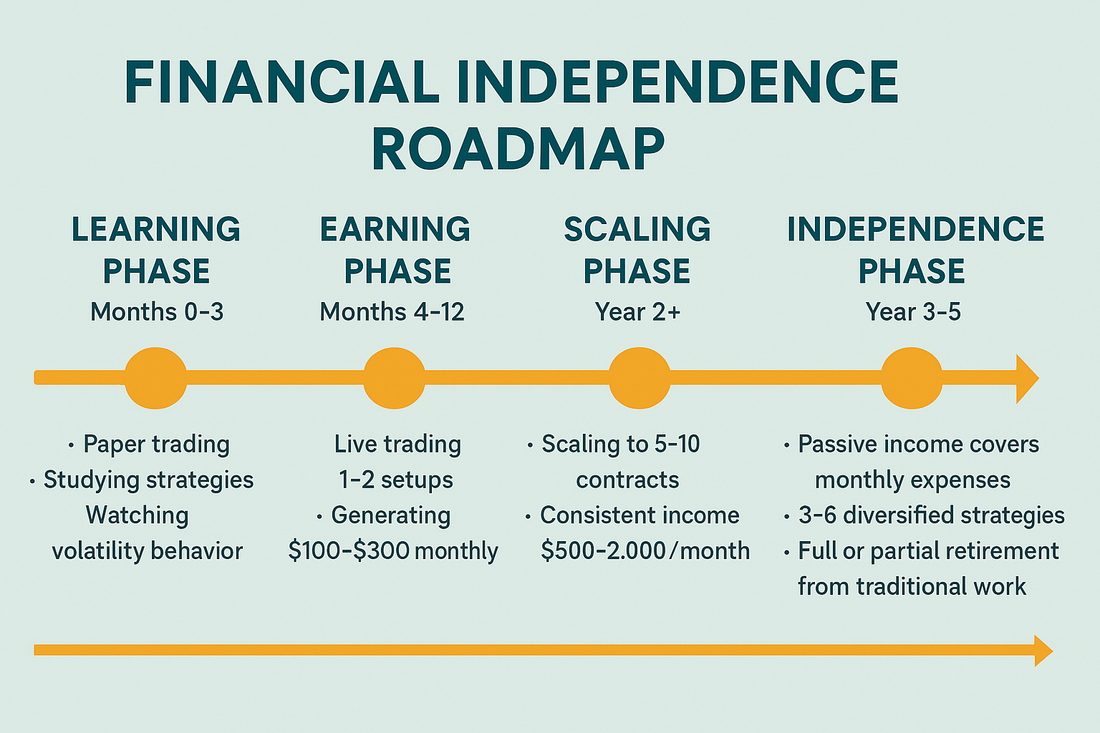
How to Use Options Trading to Achieve Financial Independence
Overview:
In a world dominated by 9-to-5 routines, rising costs of living, and unpredictable markets, many are seeking a path to true financial independence—where your money works for you, not the other way around. While traditional investing offers a slow and steady path, options trading presents a more dynamic, accelerated route. When approached with discipline, education, and a long-term mindset, options trading can be a strategic pillar on your journey to financial freedom.
In this article, we’ll explore how you can use options trading to build income, compound capital, and protect wealth—ultimately creating a roadmap to independence.
🧠 Section 1: A Long-Term Strategy Toward Financial Freedom
1.1 What Is Financial Independence?
Financial independence means having enough income from your investments to cover your lifestyle expenses—without relying on a paycheck.
This requires:
- Consistent income
- Risk-adjusted growth
- Wealth preservation
Options trading can support all three pillars—with strategies tailored to your financial goals and risk tolerance.
📌 Backlink: Explore our Beginner’s Guide to Options Trading
1.2 Why Options Trading Over Traditional Investing?
|
Factor |
Traditional Investing |
Options Trading |
|
Return Speed |
Slower, compounding |
Faster, leveraged returns |
|
Flexibility |
Limited |
Directional, income, hedging |
|
Capital Efficiency |
High capital required |
Control large assets with less |
|
Income Generation |
Dividend-dependent |
Custom income via strategies |
|
Risk Control |
Market-driven only |
Can be structured via spreads |
Options trading gives control—you choose your risk, reward, and trade structure.
1.3 Building a Vision With Options
A long-term options trading plan includes:
- Monthly income goals
- Growth targets
- Defined risk strategies
- Milestones for scaling capital
You’re no longer just investing for retirement—you’re designing a lifestyle.
📌 Backlink: Learn how to build a trading plan from scratch
💰 Section 2: Generating Income With Options
2.1 Covered Calls – The Foundation of Passive Income
Strategy:
- Own 100 shares of stock
- Sell a call option against it each month
Goal:
- Collect premium as recurring income
- Reduce cost basis over time
- Maintain upside exposure (limited)
Example:
Own AAPL at $170
Sell a $175 call for $2.00 → collect $200 income
📌 Backlink: Learn the covered call strategy in detail
2.2 Cash-Secured Puts – Get Paid to Buy Stocks
Strategy:
- Sell put options on stocks you’d like to own
- Collect premium while waiting for the stock to fall
Goal:
- Earn while accumulating
- Enter positions at a discount
Example:
Sell a $100 put on MSFT for $3 → keep $300
If MSFT drops, you’re assigned at $97
2.3 Iron Condors – Income From Sideways Markets
Strategy:
- Combine a bear call spread + bull put spread
- Profit from time decay in range-bound markets
Goal:
- Earn non-directional income
- Capital-efficient for retirement accounts
Perfect For:
- Weekly income
- Passive volatility harvesting
📌 Backlink: Learn to profit in flat markets
2.4 Diagonal Spreads – Blending Time and Direction
Strategy:
- Buy a longer-dated option
- Sell a near-term option at a different strike
Goal:
- Generate income while holding directional bias
- Reduce cost basis on long-term trades
2.5 Scaling Income Over Time
- Start small: 1–2 monthly trades
- Compound returns into larger positions
- Use profits to diversify or reinvest in longer-term spreads
📊 Section 3: Financial Roadmap (Illustration Description)
[Graphic: Financial Independence Roadmap]

📌 Backlink: See how to transition from learner to full-time trader
📈 Section 4: Real Case Studies – Options Trading for Freedom
Case Study 1: Jason, 35 – Tech Worker Turned Trader
Goal: Retire early by 45
Plan: $300/month in options income → scaled to $2,000/month in 3 years
Strategy: Covered calls + put spreads on tech ETFs
Result: Replaced 70% of income via trading
Case Study 2: Lina, 42 – Part-Time Trader, Full-Time Mom
Goal: Supplement income post-career break
Strategy: Diagonal spreads on low-beta stocks
Result: Averaged $1,000/month with 3 trades/week
Case Study 3: Daniel, 52 – Early Exit from Corporate Job
Background: 25 years in banking
Strategy: Built a ladder of cash-secured puts and iron condors
Result: Covered monthly expenses without touching savings
🛡️ Section 5: Managing Risk on the Road to Independence
✔ Only Use Defined-Risk Trades
- Always know your max loss
- Favor credit and debit spreads over naked options
✔ Never Overleverage
- Stick to 1–2% risk per trade
- Use multiple smaller trades vs. one large position
✔ Maintain a Trading Journal
Track:
- Entry & exit
- Strategy rationale
- Emotions
- Mistakes and improvements
📌 Backlink: Manage your options trading journal
✔ Diversify Strategies and Timeframes
- Don’t rely on just one income play
- Mix covered calls, diagonals, condors
- Use different expiry lengths
🔗 Internal SEO Backlinks
- How to Trade Weekly Options
- Options for Retirement Planning
- Best Tools and Software for Options Traders
- How to Build a Consistent Options Income Stream
🎯 Conclusion: Trade Your Way to Financial Freedom
Financial independence isn’t just about hitting a number—it’s about building a lifestyle of freedom, flexibility, and confidence in your financial decisions.
Options trading, when used correctly, offers a practical and scalable pathway to get there. Whether your goal is to quit your job, supplement your income, or just feel financially secure, a structured options plan puts you in the driver’s seat.
You don’t need to guess the market. You need a system. You need consistency. And you need a mentor.
✅ Interested to know more?
At www.optionstranglers.com.sg we offer:
• In-depth live 1-1 sessions / group classes
• Trade examples and breakdowns
• Community mentorship and support
👉 Ready to upgrade your strategy and trade like a pro? Visit www.optionstranglers.com.sg and start your journey to financial freedom today.
Your future is an option. Choose wisely.
⚠️ Disclaimer:
Options involve risk and are not suitable for all investors. Always consult with a financial advisor before investing.
